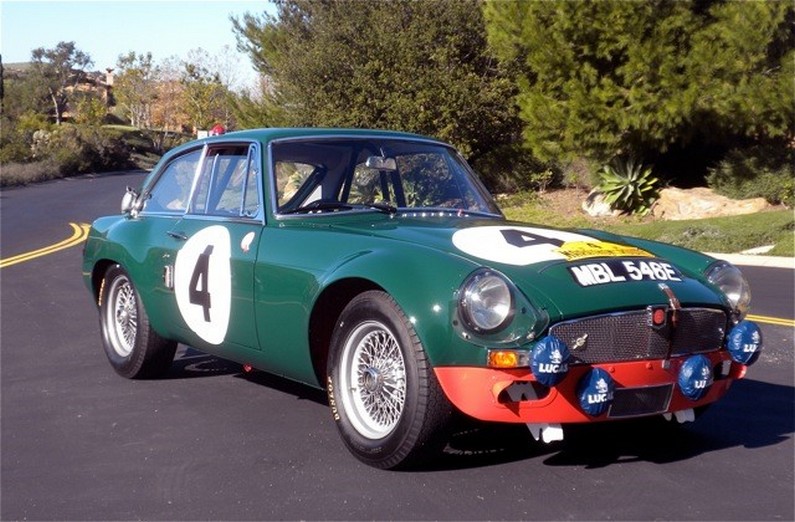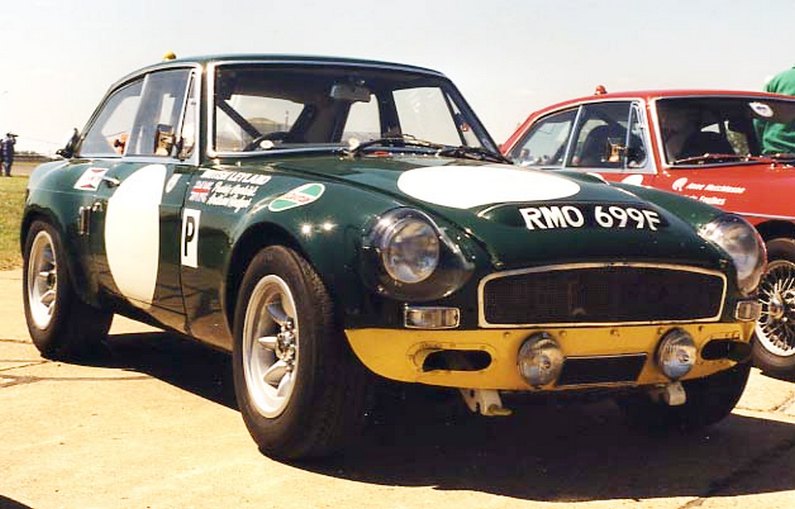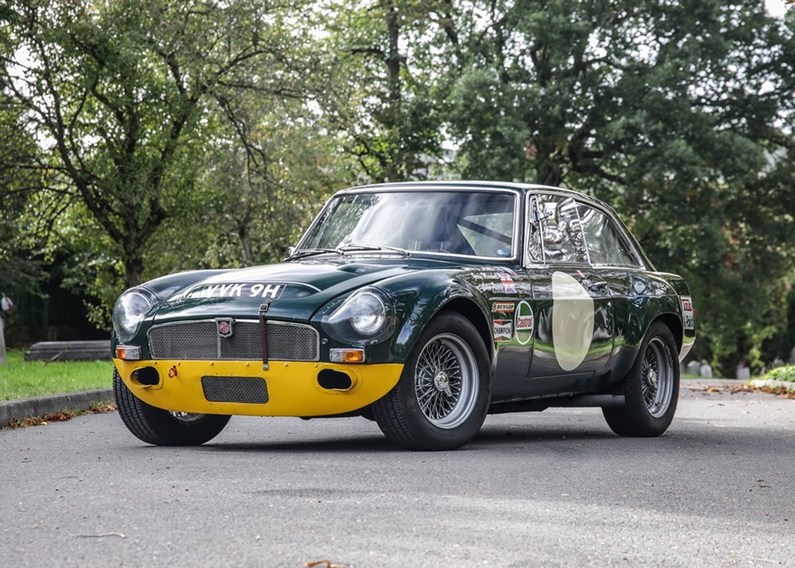For the purpose of keeping followers informed of what classic cars are coming to market, CSI is on the mailing list of several U.K.based Classic Car auction houses. In November we received notification of Brightwell’s 5th December auction at Leominster. Amongst the cars on offer was a replica MGC GTS. It is a very attractive car and to my shame, this model had previously escaped my radar. I started to do some research and discovered this fascinating story which I want to share with you here –
The MGC GTS (S for Sebring) is recognised as being one of the most exciting, MG badged, cars to come out of the BMC Competitions Department, Abingdon, in the 1960s. The concept of developing a lightweight MGC emerged in 1966 with the aim of competing in the prototype sports car class, particularly at the prestigious Sebring, FL. Raceway. Six body shells were built, using the centre structure from the production MGC as the platform, to this was attached aluminium exterior panels, including, roof, door skins, front valance, rear hatch (including perspex screen) and front and rear wings (fenders) with their distinctive “bubble” flares; these were required in order to accommodate wider wheels and tyres. The production car was fitted with an aluminium bonnet (hood) as standard.
Because of financial concerns at BMC’s HQ, only two lightweight versions of the MGC GT were assembled at Abingdon. The first car, registered MBL 546E (ADO52-1060 – affectionately referred to as “Mabel”), was entered into the 1967 Targa Florio but as an MGB GT Special because it was fitted with an MGB four-cylinder engine and MGB bonnet; the launch of the MGC, later that year, was still a secret at that time. Although this car had two experienced drivers in Paddy Hopkirk and Tommi Makinen, they couldn’t wring enough speed out of it even to be classified. In March 1968, this car, now uprated with its originally designated MGC six cylinder engine, fitted with an alloy cylinder head, triple Weber 45 DCOE carburettors, mounted on a purpose designed inlet manifold and producing 202bhp at 6000 rpm., was entered into the Sebring 12 hours race. It was, of course, fitted with a proper MGC bonnet and because the MGC had been announced, in the previous October, there was no need for secrecy, it carried its MGC GTS badge with pride. This time Paddy Hopkirk was partnered by Andrew Hedges, they achieved the outstanding position of tenth overall and first in class. The objective of endowing the MGC with some creditability in the all important North American market seemed to have been achieved, or it would have been if the MGC itself hadn’t been such a “dud”! Later that year, August to be precise, “Mabel”, in the hands of Belgian driver Julien Vernaeve and Brits, Tony Fall and Andrew Hedges, were entered in the 84-hour-long ‘Marathon de la Route’ at the Nürburgring circuit. Another outstanding result was achieved, sixth overall and first in class. The other car, carrying the registration number RMO 699F (ADO52-1059 – referred to as “Romeo”) driven by Roger Enever, Alec Poole and Clive Baker, did not finish due to a head gasket failure.
The following year both cars were entered into the Sebring 12 hours race under the British Leyland Motor Corporation (BLMC) banner. “Romeo”, driven by Andrew Hedges and Paddy Hopkirk finished a reasonable fifteenth overall and “Mabel” driven by Canadians Bill Brack and Craig Hill finished 34th. That was the “Swan Song” for these cars and the race programme that they were part of. Sir Donald Stokes (later Lord Stokes of Leyland), BL’s chairman and his ‘Leyland’ management team and got to grips with the sprawling, inefficient and not particularly profitable BMH (British Motor Holding – BMC plus Jaguar) entity that had merged with his Leyland Motor Company (Leyland Trucks, Standard-Triumph and Rover), under U.K. Government “guidance”. He had concluded that the merged group had too many sports car brands and models. He was going to concentrate on what he knew best, Triumph, the others, MG, Austin Healey and Cooper, could “go to the wall” and good riddance. This was not a view shared by the many MG and Healey enthusiasts around the world but particularly in North America. The fact that these brands have been kept alive and flourish in the form of well established “Owners Clubs”, bears testimony to that affection. After the 1969 Sebring race, the two cars and some spare parts were sold to BLMC distributors in the USA. They were raced in “club” events for a while and then they were bought and later traded by Private Collectors, which is their status today, lovingly cared for.


But Like all good stories, it doesn’t end there!
The Continuations, Replicas and Homage Cars
After the termination of the MGC GTS racing programme four lightweight shells, originally constructed at the Competitions Department, Abingdon, still remained unused. Legendary Austin-Healey man John Chatham was due to drive an MGC GTS on the 1970 Targa Florio but with the cancellation of the programme, he was offered the opportunity to purchase the remaining shells and components in order to complete the final four cars.
So, JC started to prepare an MGC GTS, from the parts that he had purchased, with the idea of entering it into competitions. In 1970 he entered the MGC GTS that he had built in the Targa Florio carrying the registration number VHY 5H, he finished 39th overall.

Chatham built a second MGC GTS bodyshell into a road car (U.K. registration EHW 441K) for his friend and fellow enthusiast Bill Gardner. That car was later sold to Steve Bicknell. Then he built a third, road legal, MGC GTS (U.K. registration VHW-330H) for Alan Zafer who worked in media relations for British Leyland at Abingdon. Chatham’s biography (Mr. Big Healey: The Official Biography of John Chatham by Norman Burr) mentions that Zafer’s car used some parts from a cannibalized production MGC GT due to limited stock of aluminium panels. In 1971, John Chatham started to build a final, even lighter, MGC GTS racecar with the ambition of competing in the British “Modsports” racing programme in 1972 and 1973. For this car he used the remaining components, including the aluminium engine block, that he had bought from the BMC Comps Dept. This car was equipped with MagAlloy wheels instead of the wires that the “work’s” cars used. It was this car that set a record at Silverstone by completing three laps in 1 minute 54 seconds.

The cars constructed by John Chatham can, legitimately, be called “continuation cars” but before we move on to the replicas there is an “odd ball” to share with you –
Another “Romeo” RMO 699F?
In 1979 a scrapyard in San Jacinto, California was identified as having acquired what might be one of the original MGC GTS racecars. At that time, the locations and even the VIN numbers of MBL 546E and RMO 699F weren’t widely known. MG enthusiast, Graham Wiseman travelled from England to San Jacinto to check out the authenticity of this car. He found that the car in the scrapyard was already missing some key components but it still had its aluminium GT hatch frame, this was encouraging as regards proving its authenticity. Wiseman purchased about 80 parts which he shipped back to the U.K. Included in these parts were a windshield with Sebring stickers still attached and a bonnet closing panel to which was attached a chassis plate carrying VIN number ADO52-1061. The iconic MGC GTS aluminium flared fenders were not retrieved, neither was the aluminium cylinder head. In a box of parts that had been with the car, Wiseman reportedly found, in addition to the chassis plate, an oil damaged logbook also showing ADO52-1061 and U.K. registration RMO 699F. From this, he initially assumed he had found the remains of the car Paddy Hopkirk and Andrew Hedges had driven at Sebring in 1969.
Eagle eyed readers will have noticed that ADO52-1061 is one digit higher than the reference number given for MBL 548E earlier in this article. A key observation!
To cut to the chase, it appears that ADO52-1061 could have been a backup, or, practice car that had also been registered as RMO 699F. Transferring log books and registration numbers between race cars, on a works team, was common practice in those days; certainly, one that Donald Healey indulged in, to the bafflement of many a researcher. In that case, ADO52-1061 may have carried the registration number RMO-699F concurrently or even before the car that actually raced at Sebring. However, there is no substantive evidence that the car Wiseman found, in a California scrapyard, was ever raced by the BL Competitions team. Frankly, there’s little evidence of a back-up MGC GTS being at Sebring. No one has ever published a photograph of all three MGC GTS racecars in one location, either at Sebring or at Abingdon. So, the whole existence of ADO52-1061 is a mystery or an elaborate scam!
After returning to England, Graham Wiseman acquired an MGC GT and began preparing it as a Sebring replica. He installed fibreglass wing (fender) flares and full fibreglass doors. He cut into the bodyshell’s cowl vent plenum so that he could mount the MGC engine about six inches further back in the chassis than the engines in either “Mabel” or “Romeo”. In lieu of triple Weber 45DCOE carburettors, Wiseman installed three Dell’Orto carburettors. This MGC GTS was painted to replicate RMO-699F as raced at Sebring. On the basis of the chassis plate and the log book he had retrieved from California, Wiseman applied for and was granted rights to use the RMO 699F registration number by the DVLA. He later surrendered that number so that it could be used by the current owner of ADO52-1059.
Graham Wiseman sold his ADO52-1061 to a dealer in the late 1980s. The car was shipped to the U.S.A. and was sold at auction by Christie’s of New York. Derek Durst of Rhode Island, David Dexter of Massachusetts, and Tony Giordano of New York have subsequently owned the car. Since 2003, Ken Williamson, of Pennsylvania, has been its proud owner. Of all its owners, Ken has been most committed to preparing and driving it as a vintage racecar. Many of his modifications, such as re-installing Weber 45DCOE carburettors, have returned the car closer to the original MGC GTS “works” specification.

And now to the Replicas…..
Iconic is one of the most overused words in the classic car lexicon, I am as guilty as anyone for using it frequently. In reality, most classic cars are iconic in some way or another but if there was ever a car/design that deserved that adjective, in my and other people’s opinion, it is the MGC GTS. That is why a number of enthusiasts have built their own replicas or “Homage” cars. There is one person and company who has perfected the process, that is, Doug Smith of MG Motorsport, located in Bovingdon near Hemel Hempstead, Hertfordshire.
Doug Smith had the knowledge and expertise required to construct a replica of Abingdon’s special tuning department’s GTS. This very special works replica would go on to be owned and raced by some of British motorsport’s most prominent figures. A solid 1969 MGC GT donor car was sourced and construction of the bodyshell was undertaken by Vincent Cyril Higgs at Colin Pearcy’s workshop at Yardley Farm. The aluminium body panels, including the wings, door skins and rear arches, were specially fabricated to duplicate those used by the factory, resulting in the same ‘Macho’ stance that rendered the Abingdon cars so distinctive. The engine build, including blueprinting and balancing, was undertaken by John Murray of Hayes, Middlesex and the final assembly and set up was entrusted to the experienced hands of Doug Smith**. Finished in Signal Red, and looking every inch the Group 6 ‘beastie’, ‘VVK 9H’ was regularly raced by Colin during the late ’80s in rounds of the HSCC ‘Classics’ Championship, Top Gear Heritage Championship and the MGCC Championship. Colin and Gerry Marshall were great mates and indeed shared drives in the car during two-driver races. After one unsuccessful race (see Doug Smith’s comments below) Colin promptly sold the car to Gerry. After a short period of time, the car was then sold on to the prominent car collector, Arthur Carter, a close friend of Gerry’s. After having the car’s engine totally overhauled, Arthur Carter agreed that the well-respected and experienced club racer, Chris Conoley, would race the car in the UK and at selected International events. At some point during this period, the exterior of the car was changed from Signal Red to British Racing Green with a Yellow valance and red engine bay, in homage to the original Targa Florio works cars, period trade decals were also added to make it a real replica.
I telephoned Doug Smith of MG Motorsport, on Christmas Eve of all times! to check a few details of the MGC Sebrings that he has built, including how many? I had a delightful chat with him and soon realised that it was him that should be writing this article not me. As you might expect, what he doesn’t know about all the MGC GTS, original “works” cars and subsequent replicas/homage cars, isn’t worth knowing. The knowledge was imparted in a very calm “matter of fact” manner which I enjoyed listening to. He told me that they have built 20 MGC GT Sebrings to date. He wanted to make it clear that the cars that MG Motorsport build are not MGC GTS replicas with the same paint schemes and decals as MBL and RMO but GT Sebrings. The basic characteristics are the same, flared wheel arches, lightened panels and engine mods, including triple Weber 45DCOE Carbs and profiled camshaft etc. Maybe ‘Homage Car’ would be a better description. Most of the cars have been built to order by discerning customers from around the world. These builds take place alongside MG Motorsport’s much respected MGB Historic pre ’66 race car programme.
** After reading my article Doug sent me this further information –
“The donor car was purchased by me from Murray Scott Nelson and stripped by me at home. I had the aluminium panels made from a new set of F/glass ones by a company named Boe in Nottinghamshire, after which the shell was sent with panels to Marsh Plant in Havant for fitting & painting. The shell was collected by me and fitted up with help from Vince Higgs here. The engine I took to John Murray in Hayes to build (No relation to Murray Scott Nelson despite the name). Vince & I built up the car here”.
We tested the car at Snetterton with Colin & Gerry. I recall it only competing at a couple of races, the last at Donington where it ran a bearing and was sold to Gerry who sold it on to Arthur Carter. The car was fixed (an oil filter valve was found missing thus bypassing the cooler) and run by Arthur for Chris Connoly of TR4 fame to drive for a season. It then went back into Arthur’s collection”.
Thank you very much Doug, I have received some complimentary comments about this article, your further input will make it even more interesting to readers.

Another MG Motorsport MGC GT Sebring
Owning a Sebring recreation was high on Steve Simmond’s bucket list, and he was actually familiar with this particular MGC long before he became its owner. “The first time I saw XRX was on a club outing,” he explains, referring to the car by its number plate. “The then-current owner had just acquired the car and was just getting a feel for it.”
MG Motorsports had recently built the MGC into a pretty wild beast before it sold to an American enthusiast. To say that Steve was smitten by the lavishly flared, bright-red MGC is an understatement. He never forgot about it. After several years and much water flowing under the proverbial bridge, Steve eventually bought his “dream car”.
What he now has is a very faithful recreation of a factory MGC GT Sebring. Starting with a 100,000 mile-plus ’69 MBC GT that had undergone a few colour changes during its life, MG Motorsports had performed a nut and bolt restoration on it while also converting it to Sebring specification. The exterior of the car had been modified with GTS-style fibreglass fender flares, the defining visual signature of the GTS that allow for a far larger wheel and tyre package. In 2008 the car went to a high-end restoration shop for a full body and paint makeover. The body was repainted in the correct Tartan Red, MG’s official race colour, complete with white race number roundels on the doors, bonnet (hood) and hatch.
Doug Smith told me – “We built the XRX car for a customer in Seer Green near High Wycombe, who then sold it to Henry Camisasca in California. He then sold it to Steve Simmonds after I sold him MBL on behalf of the owner”.


MGC Background
In the mid 1960s BMC realised that they had an impending problem with the Austin Healey 3000. Although the basic design had been progressively updated and modernised, with electric front windows, a smart burr walnut dash, increased power output and performance etc., it was still a body mounted on a separate chassis frame design that traced its history back to the 1940s/50s. This in itself need not have been a problem but increasing road safety regulations adopted around the world but particularly in the car’s most important market, the USA, meant it became more and more difficult to meet those regulations. Also, the car had been around for thirteen years and faced stiffer competition, inevitably sales had started to decline. BMC needed to offer something a little more modern, in the 3.0 litre sports car class and at the same time pass the latest regulations. The MGC (ADO52)), fitted with an updated version of the corporation’s ‘C’ series engine (two inches shorter block, seven main bearings instead of four etc.) was conceived in order to answer those problems. BMC were renowned practitioners of “badge engineering” so, the idea of producing an Austin Healey (ADO 51) derivative of this car came easily to that management. The fact that the Austin Healey version had the earlier ADO number suggests that replacing the AH 3000 was their first priority. But Donald Healey was not convinced, despite his son, Geoff, having worked with MG’s Syd Enever on the design and development of the car. He would not allow his name to be attached to this car, so, the MGC stood by itself. At the time BMC were shooting themselves in the foot at a prodigious rate. At launch, the U.K. press panned the MGC for its poor handling. It was later revealed that the people responsible for preparing the press cars failed to inflate the tyres to the correct pressure, 32 psi. As a consequence, the handling of the press cars left a lot to be desired and the journalists reported accordingly. The MGC was added to the list of BMC “less than well received” cars at that time, only 9002 MGCs were sold, 4,458 of the GT model and 4,544 roadsters. By comparison, the MGB sold 512,802 units.
Classic Car Portraits
In my extensive research for this subject, I came across this. Classic Portraits cover a wide range of cars –

Credits
In addition to giving credit to the source of the various photographs used in this article, I would also like to credit the following –
- www.britishracecar.com
- Ken Williamson
- www.retromodcars.com
- Steve Simmons
- www.mgmotorport.co.uk
- Doug Smith
- www.brightwells.co.uk
- www.historics.co.uk
- www.bonhams.com/departments/MOT-CAR
- www.rmsotheby’s.com
I would also like to mention probably the greatest reference book on this subject – “The MGC GTS Lightweights: Abingdon’s Last Racers” by David Morys
Nick

